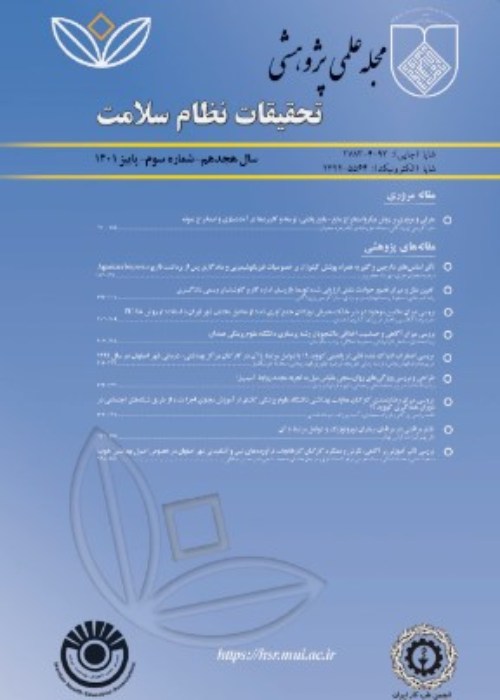A Study of the Relationship between Indoor and Outdoor Particle Concentrations in Hafez Hospital in Shiraz, Iran
Author(s):
Abstract:
Background
The concentration of aerosols in the atmosphere has increased in recent years. These particles can adversely affect human health. Studies show that indoor air quality is affected by outdoor air. Moreover، people spend a significant portion of their time indoors، and few studies have been done in this area. Therefore، the purpose of this study was to measure the concentration of outdoor and indoor suspended particles in Hafez Hospital، Shiraz، Iran، and determine the relationship between these parameters. Methods
A cross-sectional study was done in Hafez Educational Hospital in Shiraz from October to November 2011. Sampling was done twice a week. The outdoor and indoor air sampling was conducted in each ward of the hospital. 144 samples were collected for analysis; including 24 samples for each ward of the hospital and also for outdoor air. Sampling was performed by using a sampler Aerosol Mass Monitor (Model GT-331، Japan) to measure the particle concentrations of PM10 and PM2. 5. To compare the concentration of indoor suspended particles in different wards of the hospital with outdoor particles، one-way ANOVA was used. Then، the data were analyzed using SPSS version 11. 5. The results obtained were compared with 24-hour particulate matter concentrations of EPA and WHO guidelines. Findings
Results showed that indoor and outdoor air quality of the hospital in terms of air quality index for PM2. 5 is in a good condition. The air quality index for PM10 for the indoor air showed that 95. 2% of wards were in good condition، and two obstetric wards were in average condition. Status of outdoor air quality for PM10 is unhealthy for sensitive groups in 75% of samples. To assess the relationship between suspended particles in outdoor and indoor air of hospital wards، Pearson correlation was used. Accordingly a significant relationship was observed in PM10 and PM2. 5 of outdoor and indoor air of a number of hospital wards (P > 0. 05). Conclusion
The average ratio of PM10 and PM2. 5 of indoor to outdoor air (I/O) were، respectively، 1. 41 and 6. 10، which indicated the low ventilation and air exchange within the wards. The results also showed that there is a significant relationship between the concentration of suspended particles in the indoor air and outdoor air. This represented a penetration of outdoor particles into the indoor air of hospital wards. Thus، for hospitals that are located in high traffic areas، utilizing appropriate ventilation systems within the hospital is effective in reducing air pollution.Keywords:
Language:
Persian
Published:
Journal of Health System Research, Volume:8 Issue: 7, 2013
Pages:
1348 to 1355
magiran.com/p1137730
دانلود و مطالعه متن این مقاله با یکی از روشهای زیر امکان پذیر است:
اشتراک شخصی
با عضویت و پرداخت آنلاین حق اشتراک یکساله به مبلغ 1,390,000ريال میتوانید 70 عنوان مطلب دانلود کنید!
اشتراک سازمانی
به کتابخانه دانشگاه یا محل کار خود پیشنهاد کنید تا اشتراک سازمانی این پایگاه را برای دسترسی نامحدود همه کاربران به متن مطالب تهیه نمایند!
توجه!
- حق عضویت دریافتی صرف حمایت از نشریات عضو و نگهداری، تکمیل و توسعه مگیران میشود.
- پرداخت حق اشتراک و دانلود مقالات اجازه بازنشر آن در سایر رسانههای چاپی و دیجیتال را به کاربر نمیدهد.
In order to view content subscription is required
Personal subscription
Subscribe magiran.com for 70 € euros via PayPal and download 70 articles during a year.
Organization subscription
Please contact us to subscribe your university or library for unlimited access!


